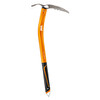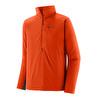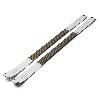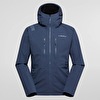The Grandes Jorasses serac, interview with Michèle Curtaz, Fondazione Montagna Sicura

 1 / 9
1 / 9 Fondazione Montagna sicura
Fondazione Montagna sicura
Nowadays, thanks to the empirical studies carried out by our ancestors, much of what can be trodden has been explored, and the tools we have today allow us to foresee fairly accurately what might happen in the mountains. With regard to seracs, one of the certainties we have is that, sooner or later, they'll collapse and the force of gravity will drag them downwards. The other certainty though is that we don't know when!
I remember the Poire serac mockery, that collapsed just after great Gianni Comino had finished his climb. The vacuum created by the gushing air sucked Comino downwards, had it collapsed two minutes later he would still be with us today. I think back to the countless serac victims on the Mont Blanc Gran Mulets route, and to those of who perished on the route that ascends the North Face of Mt. Blanc du Tacul. Last year the serac collapsed here but Giorgio Passino miraculously survived. I remember those dashes we've all done across the danger zones, knowing full-well that it's destiny who rolls the dice. And that bad luck is always faster because it's unexpected.
A serac which has been under close scrutiny for a number of years is that at Pointe Whymper on the Grandes Jorasses, that extends down the mountain's south face. A few years back, in 1998 to be precise, this glacial feature triggered circa 150,000 cubic metres of ice that tumbled to within a few hundred metres of the Val Ferret road. So if it's true that alpinists can, more or less, take their lives into their own hands, it's just as true that it's worth protecting those who aren't alpinists and who happen to be a few kilometres from an intangible danger.
As a result, ever since 2008 this serac has been carefully monitored by Fondazione Montagna Sicura, on behalf of the Valle d'Aosta Geological Survey. We've used this opportunity therefore to find out more about the glaciers in this region from Michèle Curtaz. With a degree in Environmental Engineering and Land Management, she is the technical manager of the Fondazione Montagna Sicura projects.
We would be grateful if you could briefly illustrate the Foundation's activities related to the environment
Fondazione Montagna Sicura has as its mission the consolidation and development of a culture of safety in the mountains; is a center for applied research, documentation and training on issues related to the high mountains and safety. We can say that deals 360 ° mountain: the study and monitoring of glaciers, permafrost, natural hazards, Snow and Avalanche until you get to the safety aspects, which are important for those who live and frequent the mountain. In addition to being a research center working in collaboration with universities and international research centers, supports the region in various monitoring activities and the prevention of natural hazards, such as in the preparation of Snow and avalanche bulletin as well as in the management of a Plan risk monitoring glacial. With regard to security, on its website www.fondazionemontagnasicura.org is a section devoted to the conditions in the mountains (twinned with the section of "The Chamoniarde" on the French side of Mont Blanc) and in recent years has organized several initiatives with schools, such as workshops on the snow in which, in technical collaboration with dog lovers, mountain guides and pisteurs secouristes, children are involved in various activities to explain to them how to behave in the mountains on the slopes and off-piste and in the event of an accident. To stay abreast of the times is also active on Facebook with a page that is updated with information related to the issues addressed and the current initiatives.
How many glaciers are there in Valle d'Aosta?
About 200, that cover about 4% of the region; in 2006 there were 209 glaciers in the Valle d'Aosta's registry, updated by the Foundation and available online. Due to the decline in recent years we can expect this number to drop after the next count, the smallest will most certainly have disappeared.
How many of these are monitored due to their inherent danger to things or people?
On the basis of historical information and other factors, at present 22 glaciers are being monitored that could hold a potential threat to things or people. But there are different levels of danger level; at the moment only three glaciers require in-depth, specific monitoring while for the others all that is needed is a helicopter analysis. Flights are carried out in early autumn (when there is less snow) to see how they are evolving and to check that things haven't become more dangerous.
Are the glaciers constantly regressing as people say or has a year like this one slowed this process down?
We're currently making the last readings of the "mass balance"; this is the most significant measure of a glacier's volume loss, calculated by the difference between glacier's annual accumulation (snow) and loss (snow and ice melting). The initial data, although not analysed completely, indicates that this year has been less negative than the previous years. In many cases large parts of the glaciers are still covered by winter snow meaning that the ice below, at least this year, has not been affected. To find out exactly how the glaciers have fared this year we need to wait for all the relevant data; the findings will be posted on our website (www.fondazionemontagnasicura.org).
What do you think of some techniques used to preserve the surface of the glacier, such as plastic sheets spread out onto the ice. Do they work? And what is the environmental impact of such massive undertakings compared to the benefits?
These techniques have been, and still are, used for specific purposes; for example, on the Presena glacier to preserve the snow needed for skiing or close to structures such as chair lift pylons located on the glacier, to prevent stability issues that might occur due to the melting glacier. Covering large glaciers with plastic sheets to stop the climate and nature from taking its course is unthinkable. Glaciers are an element that work in careful balance with the climate and if the temperatures rise, regardless of why the climate is changing, then the glaciers will shrink.
How and with what instruments are surveys carried out on moving masses such as the suspended Whymper serac?
Optical prisms are fixed to the glacier and their position is measured every hour by a measuring system at Planpincieux, in Val Ferret. Furthermore, we are currently experimenting the use of GNSS (GPS) receivers we've developed since these can provide data even in cloudy conditions and in poor visibility; for the optical prism system to work the glacier must be visible from the valley, and this isn't always the case given its altitude and its particular position on the Grandes Jorasses, on the ridge along the Italian-French border that is often hit by storms. We've also got some automatic cameras placed both above the glacier and to its side, that transmit images that help us watch the evolution of the serac fractures and the collapses that occur at the front of the serac.
I suppose that the collapse point of a serac is calculated on the basis of a series of different data. Can you provide us with a rough outline about this?
The Grandes Jorasses hanging glacier is a so-called "cold" glacier, it grows cyclically, expands until it reaches a point of non-equilibrium. This can be noted by an increase in the speed with which it moves, ie, it accelerates, until it collapses. This behavior is typical of cold glaciers and has been noted in other similar cases in Switzerland, as well as during its collapse in 1998.
Based on mathematical models and geological surveys, where are the most dangerous places to be in an area such as the Rifugio Boccalatte?
The mathematical models take into account various different parameters; essentially this depends on the unstable volume and the conditions of the slopes below; in winter, when there is snow right down into the valley, even small collapses can trigger large avalanches. Currently, given the different fractures we have monitored this summer that split the mass of ice, and seeing the lack of snow at lower altitudes, we believe the lower part of the valley will not be affected. Recent developments have confirmed this and a first collapse, which affected a portion of the glacier, occurred last weekend.
Town councils generally, to prevent exposing the population to risks, and to avoid exposing themselves to civil and crimial action, regularly ban access to roads or paths that constitute even the tiniest of risks. In this specific case of Courmayer town council has closed the path from 16/09/2014 to a date yet ot be defined, ie until it is no longer deemed dangerous. Given that this is the normal route up one of the most important mountains in the Alps, if the risk continues for a long time do you feel one should consideralternative solutions to a natural collapse?
Current knowledge on the dynamics of glaciers and operational solutions are far too limited to consider alternative solutions to that of a natural collapse. Even the legal conditions are currently unclear about such potential operations, especially since the serac currently poses no danger to civilians, to the valley floor.
I'm provoking you here... what about a controlled collapse os small portions of the serac? What implications might this have?
There are several problems: first of all, ice differs considerably from snow and rock, for which explosives are used normally. The use of explosives could prove ineffective, and in any case would require works (drilling in-loco etc) that would currently be completely unsafe. Furthermore, there are also legal and regulatory constraints, for example concerning the use of explosives dropped by aircraft. Finally, even if we were to assume that a collapse could be triggered artificially, the question marks regarding the glaciers reaction are far too big. A far larger collapse might occur, and one might destabilise larger sections that, at present, are stable. In short, there would be more unanswered questions than those answered, as well as additional responsibilities.
In conclusion, the wisest thing to do is wait for nature to take its course, and that Courmayeur can withdraw the ban. It goes without saying that a failure to observe this ban could have legal implications that should not be underestimated.
Interview by Elio Bonfanti



 Copia link
Copia link






 See all photos
See all photos






















